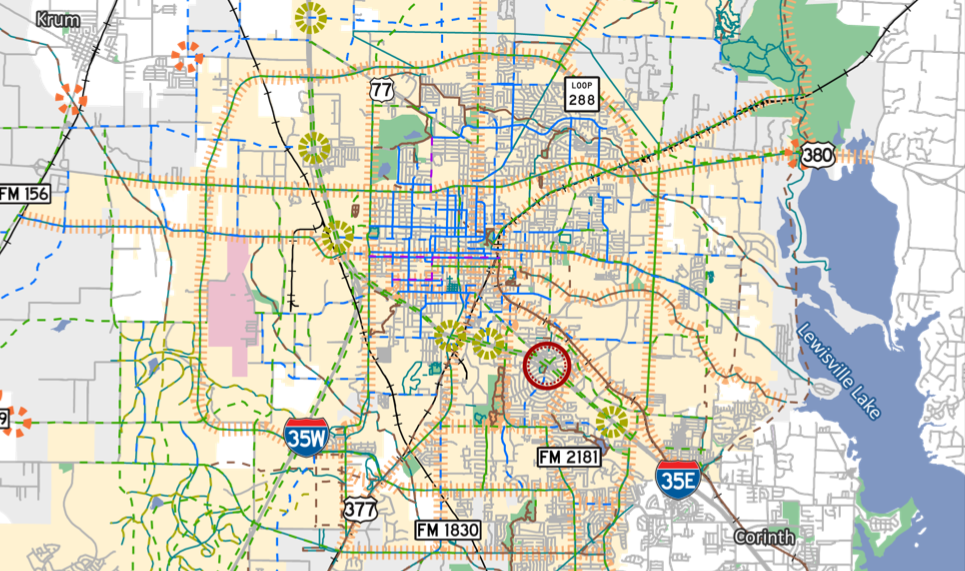Mobility and Comprehensive Plans Move Towards Adoption
February 21, 2022
Draft Bike Plan update
The Denton City Council and Planning and Zoning Commission held a joint meeting last week to discuss the draft updates of the Mobility Plan and Comprehensive Plan (Denton 2040), which are on track for adoption on March 1st. Meeting discussions have revolved around a few key themes.
Emphasis on Safety
Safety was at the forefront during multiple meetings. In 2021, Denton saw its highest number of traffic fatalities in more than a decade, with deaths trending upward over the past ten years.
In 2019, the Denton City Council approved the development of a Vision Zero action plan aimed at reducing traffic fatalities and serious injuries. Development of an action plan has been delayed for a variety of reasons since then.
In the Mobility Plan update, development and implementation of a Vision Zero action plan was originally listed as the seventh goal, though staff stressed the goals were not listed in priority order.
Vision Zero is now the first listed goal in the Mobility Plan after Council Member Jesse Davis requested it be listed first and that the wording be strengthened to highlight Denton’s commitment to this effort. Prioritizing Vision Zero also received vocal support from council members Brian Beck, Alison Maguire and Deb Armintor.
City staff anticipate presenting the proposed Vision Zero action plan in August or September of this year. Ongoing engagement and support from the City Council and Denton residents will be crucial to ensuring the plan’s effectiveness.
Connecting the Lines
The updated Bike Plan aims to move away from shared streets and focus more on protected bike lanes, sidepaths and other measures to increase safety and comfort so people of all ages and abilities can access their daily needs by bicycle.
Denton’s Bicycle, Pedestrian, and ADA Coordinator, Nathan George, highlighted the desire to start forming a useful network of bike routes around town. Much of Denton’s current bicycle infrastructure exists on random segments of roadway that do not connect to other bicycle infrastructure or popular destinations.
New policy from the Texas Department of Transportation (TxDOT) should help fill gaps in the bicycle network over time, as future TxDOT projects are now required to include accommodations for bicycle and pedestrian traffic.
Because of the time it takes to plan, design, and construct a roadway, it may be years before Denton sees a TxDOT project that falls under the new requirements.
Bicycle infrastructure projects on city streets will require funding. Denton’s annual budget includes only $200,000 for bike lanes, which is approximately the cost of one mile of mid-quality protected bike lane.
With at least 50 miles of bicycle routes proposed in the bike plan, Denton will need to dedicate significantly more funding if it wishes to make cycling a safe transportation option within the next decade. Cities with the fastest rise in bicycle ridership invested heavily in quickly building and connecting safe bike routes to where people want to go.
Read:
Mobility or Access?
Council discussions often touched on the competing transportation issues of access and mobility. Mobility refers to how far someone can travel in a given time, while access refers to how many destinations someone can access in a given time.
To provide more mobility for motorists on a specific road, access is sacrificed by reducing or eliminating crossing and turning opportunities. Likewise, providing more access reduces mobility by introducing more intersections and traffic turning on and off the roadway.
Denton classifies its roads based on a hierarchy where one end of the spectrum is focused primarily on mobility and the other end is focused primarily on access. Roads in the middle of the spectrum attempt to provide a balance of both mobility and access, which staff stated is generally less safe than providing just one or the other.
Image by U.S. Federal Highway Administration
Roads focused on mobility tend to be wider, higher speed and have fewer crossing opportunities. These are where most traffic fatalities and serious injuries occur. Primary arterials, such as University Drive, Carroll Boulevard and Dallas Drive also serve as dangerous barriers to people traveling on foot, by wheelchair or by bicycle.
Council Member Alison Maguire questioned whether Denton’s transportation system could be safer and more accessible if Denton moved towards a traditional gridded street pattern of growth rather than a suburban hierarchical road system that funnels motorized traffic onto a series of wide, high-speed roads.
Read: Connecting Streets May Reduce Congestion without Sacrificing Safety (State Smart Transportation Initiative)
Staff shared concern that spreading automobile traffic among more slower-speed streets could introduce dangerous automobile traffic into more areas rather than funneling the danger into a more concentrated area of arterial roadways.
The safety and access issues of primary arterials was not resolved during discussions. Staff emphasized that the primary goal of road classifications in the Mobility Plan is to plan how much right-of-way should be set aside for each road and that exact road design is decided later based on standards in Denton’s Transportation Criteria Manual and the professional judgment of traffic engineers.
The Transportation Criteria Manual currently promotes primary arterials as six lanes wide and 45 mph, which creates conditions that are hostile to non-motorized traffic, facilitates speeding, increases risk of serious injury and death for all road users when a crash occurs and generates a greater level of noise pollution in nearby neighborhoods.
Image from Page 27 of Denton’s draft Mobility Plan update
Further discussion is needed to move towards a safer transportation system that provides residents with the option to safely use whichever transportation option they prefer and gives them convenient access to their destinations.
Transportation Options through Compact Growth
Sprawling, car-first development patterns assume that everyone can afford to drive, is legally able to drive and wants to drive for every trip. These assumptions result in buildings that are spread far apart and little attention paid to providing safe or convenient travel for non-motorized traffic or mass transit. Thus, residents become dependent on automobiles no matter how short the trip or how little is being transported.
There are not many transportation options in Denton due to car-centric growth that is spread far apart and infrastructure that is typically too dangerous or inconvenient for anyone not traveling by private automobile. To provide more transportation options, Denton needs safer bicycle and pedestrian infrastructure and also for residences and destinations to be closer together.
Compact growth enables more transportation options by supporting walkability, bikeability and mass transit. It also saves taxpayer dollars by requiring less infrastructure and service costs per household and reduces emissions by requiring less driving and enabling more energy efficient housing.
The updated comprehensive plan re-commits to encouraging infill development in town over greenfield development in Denton’s rural areas, which increases Denton’s compactness.
Despite a preference for infill development in previous comprehensive plans, much of Denton’s recent growth has been greenfield.
When asked why this is the case, Denton’s Planning Director, Tina Fergins, responded that developers tend to shy away from infill development due to its complexity and opposition from residents. Greenfield development is typically less complex and tends to attract less opposition from residents, so many developers prefer it.
To enable more compact growth in Denton, additional policy and public support is needed to ensure developers find infill projects more attractive than greenfield development.
Implementing the Plans
As the updated Mobility Plan and Comprehensive Plan move toward adoption, the focus shifts to implementation. Without implementation of the vision, these plans are largely meaningless. Denton’s 1999 comprehensive plan emphasized biking and walking infrastructure as a means of improving air quality, reducing cost to the city and improving city vitality. However, there was no evident movement toward these goals until Denton residents came together in 2009 to demand that Denton develop its first bike plan.
Cities cannot pursue all of their goals all at once. Goals must be prioritized. Priorities are set largely by the Denton City Council, who responds to their constituents.
Residents who desire more affordable transportation options, a safer transportation system and a healthier city must share their priorities with the Denton City Council to ensure that these plans do not grow dusty on a shelf.
Next Steps
On March 1st, the City Council will consider adoption of the updated Mobility Plan and Comprehensive Plan. On that date, there will be a public hearing where citizens may speak for or against the plans.





